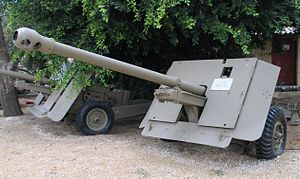This article needs additional citations for verification. (April 2008) |
| Ordnance QF 17-pounder | |
|---|---|
 17-pounder in Batey ha-Osef museum, Israel | |
| Type | |
| Place of origin | United Kingdom |
| Service history | |
| In service | 1943–present |
| Used by | British Commonwealth |
| Wars | |
| Production history | |
| Designed | 1941–42 |
| Produced | 1942- |
| Specifications | |
| Mass | 3 long tons (3.05 t) |
| Barrel length |
|
| Width | 2.2 m (7 ft 3 in) |
| Height | 1.6 m (5 ft 3 in) |
| Crew | 5-6 |
| Shell | Fixed QF 76.2×583mmR (R/135mm) |
| Calibre | 3 inches (76.2 mm) |
| Breech | Vertical sliding breech |
| Recoil | Hydro-pneumatic |
| Carriage | Split trail carriage, with gun shield. |
| Elevation | -6° to +16.5° |
| Traverse | 60° |
| Rate of fire |
|
| Muzzle velocity |
|
| Effective firing range | 1.5 km (0.93 mi) |
| Maximum firing range | 10.5 km (6.5 mi)[3] |
The Ordnance Quick-Firing 17-pounder (or just 17-pdr)[note 1] was a 76.2 mm (3 inch) gun developed by the United Kingdom during World War II. It was used as an anti-tank gun on its own carriage, as well as equipping a number of British tanks. Used with the APDS shot, it was capable of defeating all but the thickest armour on German tanks. It was used to "up-gun" some foreign-built vehicles in British service, notably to produce the Sherman Firefly variant of the US M4 Sherman tank, giving British tank units the ability to hold their own against their German counterparts. In the anti-tank role, it was replaced after the war by the 120 mm BAT recoilless rifle. As a tank gun, it was succeeded by the 84 mm 20 pounder.
- ^ "Il y a 53 ans, la guerre de Bizerte : Le témoignage du général Elkateb". Leaders Tunisie (in French). 13 July 2014.
- ^ "17-Pounder: Britain's Long Arm".
- ^ Foss, Christopher (1977). Jane's pocket book of towed artillery. New York: Collier. ISBN 0020806000. OCLC 911907988.
Cite error: There are <ref group=note> tags on this page, but the references will not show without a {{reflist|group=note}} template (see the help page).